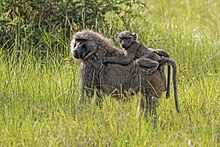Olive baboons
| Olive baboon | |
|---|---|
 |
|
| In the Ngorongoro Conservation Area, Tanzania | |
 |
|
| Female with juvenile, Uganda | |
| Scientific classification | |
| Kingdom: | Animalia |
| Phylum: | Chordata |
| Class: | Mammalia |
| Order: | Primates |
| Family: | Cercopithecidae |
| Genus: | Papio |
| Species: | P. anubis |
| Binomial name | |
|
Papio anubis (Lesson, 1827) |
|
 |
|
| Geographic range | |
The olive baboon (Papio anubis), also called the Anubis baboon, is a member of the family Cercopithecidae (Old World monkeys). The species is the most wide-ranging of all baboons, being found in 25 countries throughout Africa, extending from Mali eastward to Ethiopia and Tanzania. Isolated populations are also present in some mountainous regions of the Sahara. It inhabits savannahs, steppes, and forests. The common name is derived from its coat color, which is a shade of green-grey at a distance. A variety of communications, vocal and non-vocal, facilitate a complex social structure.
The olive baboon is named for its coat, which, at a distance, is a shade of green-grey. Its alternative name comes from the Egyptian god Anubis, who was often represented by a dog head resembling the dog-like muzzle of the baboon. At closer range, its coat is multicolored, due to rings of yellow-brown and black on the hairs. The hair on the baboon's face, however, is coarser and ranges from dark grey to black. This coloration is shared by both sexes, although males have a mane of longer hair that tapers down to ordinary length along the back.
Besides the mane, the male olive baboon differs from the female in terms of size and weight, and canine tooth size; males are, on average, 70 cm (28 in) tall while standing and females measure 60 cm (24 in) in height. The olive baboon is one of the largest species of monkey; only the chacma baboon and the mandrill attain similar sizes. The head-and-body length can range from 50 to 114 cm (20 to 45 in), with a species average of around 85 cm (33 in). At the shoulder on all fours, females average 55 cm (22 in) against males, which average 70 cm (28 in). The typical weight range for both sexes is reportedly 10–37 kg (22–82 lb), with males averaging 24 kg (53 lb) and females averaging 14.7 kg (32 lb). Some males may weigh as much as 50 kg (110 lb).
Like other baboons, the olive baboon has an elongated, dog-like muzzle. In fact, along with the muzzle, the animal's tail (38–58 cm or 15–23 in) and four-legged gait can make baboons seem very canine. The tail almost looks as if it is broken, as it is erect for the first quarter, after which it drops down sharply. The bare patch of a baboon's rump, famously seen in cartoons and movies, is a good deal smaller in the olive baboon. The olive baboon, like most cercopithecines, has a cheek pouch with which to store food.
...
Wikipedia

